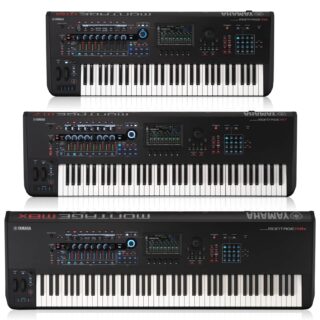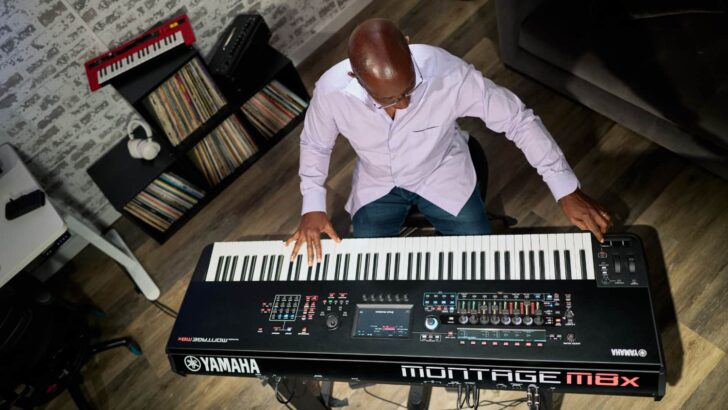 Yamaha today officially announced the new Montage M synthesizer, their new flagship synthesizer keyboard line, including the 61-key Montage M6, 76-key Montage M7, and top-of-the-line 88-key Montage M8x, which features polyphonic aftertouch.
Yamaha today officially announced the new Montage M synthesizer, their new flagship synthesizer keyboard line, including the 61-key Montage M6, 76-key Montage M7, and top-of-the-line 88-key Montage M8x, which features polyphonic aftertouch.
The Montage M features a new AN-X Analog Engine and improved AWM2 Engine that, combined with the FM-X Engine, give you a total of 400 notes total polyphony.
In addition to the expanded synthesis options, the Montage M offers twice the user memory, new expressive options, an improved user interface, upgraded analog circuitry and more.
Yamaha also announced the Expanded Softsynth Plugin (E.S.P.), which replicates the Montage M in your favorite Digital Audio Workstation (DAW). E.S.P. lets you create, edit and mix Montage M Performances anywhere – even without the hardware.
Here’s what’s new in the Yamaha Montage M:
- New AN-X sound engine recreates the classic sound of an analog synthesizer, with a host of sophisticated modulation options.
- Three Oscillators with 5 waveforms (Saw 1, Saw2, Triangle, Square and Sine) and Noise Generator
- Two filters with 10 filter types
- Pulse width modulation
- Oscillator Self Sync
- Ring modulation, FM, and wave shaper
- Amp EG with drive
- LFO for both amplitude and filter
- Voltage drift and aging settings to simulate vintage synth behavior
- Improved AWM2 sound engine offers 128 Elements per part, for ultra-high-definition sound creation.
- 400-note polyphony across its engines:
- 128 notes for AWM2 Preset Waveform Parts
- 128 notes for AWM2 User Waveform Parts
- 128 notes for FM-X Parts
- 16 notes for AN-X Parts
- Other features:
- Twice the memory over its predecessor with an increase from 5.67GB to 9.97GB of Preset Wave memory, and an increase from 1.75 to 3.8GB of User flash memory.
- New sounds and instruments, including pianos, orchestral instruments, drums, and more.
- Expressive and dynamic FM Synthesis with 8-operator FM-X engine.
- VCM Rotary Speaker effect simulates the motion of a classic rotary speaker cabinet. Plus, the new organ drawbar fader setting simulates the vintage “pull out” drawbar organ behavior.
- 16 Library slots let you store up to 10,240 additional Performances (that’s in addition to the over 2,700 performances in the presets), facilitating quick searches by Category, Name and Attributes.
- The upgraded Pure Analog Circuit included in MONTAGE M reduces noise and improves the dynamic range, crosstalk, low-frequency phase, and distortion rate, resulting in clearer sound at all volumes. You’ll also find the sound has more detailed low-mids and presence.
- Unique Expression
- Polyphonic Aftertouch lets you to individually modulate held notes with pressure. GEX also provides key repetition behavior typically found in grand pianos.
- 5-segment ribbon controller with dedicated HOLD button, a new KEYBOARD HOLD button for sustaining chords while using knobs to edit, and a Portamento on/off button and dedicated Portamento time knob.
- Dedicated Keyboard, Part and Scene Control buttons to control 16 Parts per Performance.
- All the Performance Controls – from the Keyboard and Faders to the Super Knob and Sustain, as well as the Sound Engine, are now in High Resolution. Because of the fine resolution, you’ll find the MONTAGE M behaves in a smoother and more “analog” way.
- Interact with sounds in a variety of ways, including Motion Sequences, which dynamically automate synth and effect parameters, and can even be synchronized to tempo; the Super Knob, which controls dozens of modulations in a single gesture; the Envelope Follower, which modulates sound from the A/D input or another Part; and more.
- Enhanced LED lights and colors on MONTAGE M faders, Performance, Live Set and Category Search offer visible, instant feedback, vastly improving the user interface.
- Expanded Softsynth Plugin (E.S.P.) replicates the MONTAGE M in your favorite Digital Workstation (DAW). Free for all registered MONTAGE M owners, E.S.P. allows you to create, edit and mix MONTAGE M Performances anywhere you happen to be – without the hardware – offering an unprecedented level of stage and studio integration. The full version will be available in Summer 2024.
- Upgraded navigation enables quick, intuitive sound editing and operation. 512 x 64 LCD screen, 6 touchscreen display knobs, and a PAGE JUMP button that moves what’s in the LCD screen over to the larger 7” TFT Color touchscreen for deeper editing.
- USB MIDI and multichannel 32 output/6 input audio interface. Streamline MIDI recording, virtual instrument monitoring, and multi-track audio recording through a single USB cable, so you can spend more time being creative.
Yamaha Montage M Audio Demo:
Pricing and Availability:
The MONTAGE M is available to pre-order with the following pricing:
- MONTAGE M6: $3,499.99
- MONTAGE M7: $3,999.99
- MONTAGE M8x: $4,499.99


400-note polyphony !!! i think this would need WAY more outputs .. but it sounds amazing !!
Can’t stand workstations but if you need the musical equivalent of an 18 wheel truck this looks like it delivers. 400 notes of poly should be enough for any task.
if you use a keyboard stand like the one i use for my yamaha tyros, it can stand
I still love a good workstation. Not sure if this is or not. Seems like Yamaha makes decent rigs. But in the past, the UI’s have been a bit hard to figure out.
I kinda wish the 61 key versions would have slightly flatter black keys (a la piano)– like maybe split the difference.
I’m actually impressed by the demo, despite that I’m not into these kind of “workstations”. I think Yamaha could cook this technology into smaller interesting products…
I guess I will have to wait for a M6x or M7x with polyphonic aftertouch, sigh….
Same demos as usual, very boring, there’s nothing new under the sun.
It is certainly a valuable renewed Montage, which continues the tradition of SY, EX and Motif. But No thanks, I’ll take the next Montage MXF project which will have, among others, the VL-X sound engine as well as better samples for the time of its release. I’m curious to see what Yamaha will do when they’ve exhausted all their old audio patents.
Well, may-be there is some hope for more engines to come, even the VL. The CS series from the nineties already could contain predecessors of these 3 engines: the AWM2 was the default engine, and expanded with for instance a PLG150-AN and a PLG-100DX/PLG-150DX you have something similar. Since in the nineties there were many other engines (see https://soundprogramming.net/synthesizers/yamaha/yamaha-plg-expansion-boards/), this could give some hope for more engines to come. For now I will keep it to my CS6xR together with PLG-100VL engine and breath controller…
Wonder if the AN1x is the same as those from the 90’s, or an enhanced version like the FM-X.
This looks impressive, especially when you compare it to what other ‘flagship’ synths offer.
But what I really would love to see Yamaha do is pair this keyboard with an CS analog synth engine!
I wonder when/if they’ll sell the software version as a separate item? I know a lot of it is aimed at live performance, but I’d sacrifice the Giant Knob to have the voice. That might also represent a huge system hit. I’ll calculate that if the time comes. It’d be worth it for the PolyAT aspect. Surely less than $4K, too.
There’s some confusion about the Poly AT. Some think it’s only available on the 88 key model, while others think it’s on all three.
I updated the post to clarify that the top-of-the-line 88-key Montage M8x is the model that features polyphonic aftertouch.
“F*ck Everything, We’re Doing Five Blades”
Pretty satisfied with the fact that all the AN sounds can be set up with ease on mu Hydra DLX. Great machine tho ‘.
Nice to know all this horsepower is available for those who need it, however Yamaha has a great history of letting the high-end technology filter down to future low-end models. Even when stripped-down somewhat, Yamaha seems to know which corners to cut that are not detectable once the sound leaves the speakers, so if you’ve got limited funds but patience, it will be rewarded.
I have a Montage 6 and 8. Love them. Looks like another solid synth from Yamaha, that won’t let you down playing live, but not enough in this to make me want to upgrade.
The AN1x was cool but it’s a bit backwards looking IMHO. Given there’s audio ins to the board, you can easily add another synth of your choice, and with a bit of effort program patches to utilise alongside the sounds that are already there.
More polyphony is good I guess, but I’ve not had any issues with the current level.
Actually quite disappointed with only modest improvements in onboard flash memory. Frankly 3.8GB is nothing to write home about these days. I also agree with those that have a beef about poly aftertouch only being in the high end model. It seems counter intuitive to add a new feature to only one model, and have all these sounds programmed to take advantage of said feature that doesn’t exist in 2 out of 3 models.
I wonder if any of the new stuff will be retro released to existing Montage users – same architecture, just less grunt
Boring! Absolutely nothing we haven’t heard before, just more of it.
The extra Display makes a huge difference to me, and it has much faster processor making the menus much snappier. I sold my MODX because it was tedious to use, but I think it’s solved in the new Montage M.
I find it shameful for a big manufacturer like yamaha to offer in a flagship synthesizer the feature of ployphonic aftertouch only in the 88 key version. It becomes standard with other vendors like Native Instruments or Waldorf also for nonweighted keybeds. For me this is a reason not to choose this instrument because i don’t need an 88 key version. The technology is available, why don’t they offer it for all Montage M versions? For an update in 2 years?
Well, just a word about this “400 note polyphony” thing: BULLS#!T!! Just layer something like the “Jazz All Out+” organ with say, the “Tines 78” Rhodes, then watch it drop your polyphony down to LITERALLY 80’s-style 8 note polyphony! It’s almost as if Yamaha is taking a page out of Roland’s handbook on product misrepresentation. Just sayin….. If you’re looking to supplant a VST rig with this (like I was), don’t get your hopes up! Between this, and Yamaha’s funky MIDI implementation, we’re not there yet.
I think we are now in the Polyphonic Aftertouch Renaissance, and it is a beautiful thing.
Is this the first polyphonic aftertouch and ribbon controller keyboard from Yamaha since the CS-80 era?
I agree it would be nice to see it in the smaller versions as well.